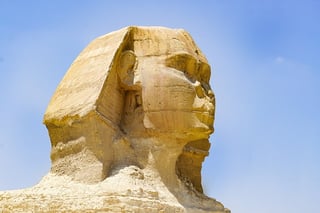
- AP Calculus
- AP Chemistry
- AP U.S. History
- AP World History
- Free AP Practice Questions
- AP Exam Prep

AP World History: Sample DBQ Thesis Statements
Using the following documents, analyze how the Ottoman government viewed ethnic and religious groups within its empire for the period 1876–1908. Identify an additional document and explain how it would help you analyze the views of the Ottoman Empire.
Crafting a Solid Thesis Statement
Kaplan Pro Tip Your thesis can be in the first or last paragraph of your essay, but it cannot be split between the two. Many times, your original thesis is too simple to gain the point. A good idea is to write a concluding paragraph that might extend your original thesis. Think of a way to restate your thesis, adding information from your analysis of the documents.
Thesis Statements that Do NOT Work
There were many ways in which the Ottoman government viewed ethnic and religious groups.
The next statement paraphrases the historical background and does not address the question. It would not receive credit for being a thesis.
The Ottoman government brought reforms in the Constitution of 1876. The empire had a number of different groups of people living in it, including Christians and Muslims who did not practice the official form of Islam. By 1908 a new government was created by the Young Turks and the sultan was soon out of his job.
This next sentence gets the question backward: you are being asked for the government’s view of religious and ethnic groups, not the groups’ view of the government. Though the point-of-view issue is very important, this statement would not receive POV credit.
People of different nationalities reacted differently to the Ottoman government depending on their religion.
The following paragraph says a great deal about history, but it does not address the substance of the question. It would not receive credit because of its irrelevancy.
Throughout history, people around the world have struggled with the issue of political power and freedom. From the harbor of Boston during the first stages of the American Revolution to the plantations of Haiti during the struggle to end slavery, people have battled for power. Even in places like China with the Boxer Rebellion, people were responding against the issue of Westernization. Imperialism made the demand for change even more important, as European powers circled the globe and stretched their influences to the far reaches of the known world. In the Ottoman Empire too, people demanded change.
Thesis Statements that DO Work
Now we turn to thesis statements that do work. These two sentences address both the religious and ethnic aspects of the question. They describe how these groups were viewed.
The Ottoman government took the same position on religious diversity as it did on ethnic diversity. Minorities were servants of the Ottoman Turks, and religious diversity was allowed as long as Islam remained supreme.
This statement answers the question in a different way but is equally successful.
Government officials in the Ottoman Empire sent out the message that all people in the empire were equal regardless of religion or ethnicity, yet the reality was that the Turks and their version of Islam were superior.
Going Beyond the Basic Requirements
- have a highly sophisticated thesis
- show deep analysis of the documents
- use documents persuasively in broad conceptual ways
- analyze point of view thoughtfully and consistently
- identify multiple additional documents with sophisticated explanations of their usefulness
- bring in relevant outside information beyond the historical background provided
Final Notes on How to Write the DBQ
- Take notes in the margins during the reading period relating to the background of the speaker and his/her possible point of view.
- Assume that each document provides only a snapshot of the topic—just one perspective.
- Look for connections between documents for grouping.
- In the documents booklet, mark off documents that you use so that you do not forget to mention them.
- As you are writing, refer to the authorship of the documents, not just the document numbers.
- Mention additional documents and the reasons why they would help further analyze the question.
- Mark off each part of the instructions for the essay as you accomplish them.
- Use visual and graphic information in documents that are not text-based.
Don’t
- Repeat information from the historical background in your essay.
- Assume that the documents are universally valid rather than presenting a single perspective.
- Spend too much time on the DBQ rather than moving on to the other essay.
- Write the first paragraph before you have a clear idea of what your thesis will be.
- Ignore part of the question.
- Structure the essay with just one paragraph.
- Underline or highlight the thesis. (This may be done as an exercise for class, but it looks juvenile on the exam.)
You might also like

Call 1-800-KAP-TEST or email [email protected]
Prep for an Exam
MCAT Test Prep
LSAT Test Prep
GRE Test Prep
GMAT Test Prep
SAT Test Prep
ACT Test Prep
DAT Test Prep
NCLEX Test Prep
USMLE Test Prep
Courses by Location
NCLEX Locations
GRE Locations
SAT Locations
LSAT Locations
MCAT Locations
GMAT Locations
Useful Links
Kaplan Test Prep Contact Us Partner Solutions Work for Kaplan Terms and Conditions Privacy Policy CA Privacy Policy Trademark Directory

Choose Your Test
- Search Blogs By Category
- College Admissions
- AP and IB Exams
- GPA and Coursework
Where to Find the Best DBQ Examples
Advanced Placement (AP)

One of the best ways to prepare for the DBQ (the "document-based question" on the AP European History, AP US History, and AP World History exams) is to look over sample questions and example essays. Doing this will help you to get a sense of what makes a good (and what makes a bad) DBQ response.
That said, not all DBQ essay examples are created equal. We'll briefly cover what makes a good DBQ example and then provide a list of example essays by course. Lastly, we'll give you some helpful tips on how to best use sample essays in your own preparation process.
What's a Good DBQ Example?
Without a doubt, the best sample resources come from the College Board . This is because they are the ones who design and administer the AP exams . This means the following:
Any DBQ essay example that the College Board provides will include a real DBQ prompt
All samples are real student responses from previous years , so you know they were written under the same conditions you'll have when you write your DBQ—in other words, they're authentic!
They not only have scores but also explanations of each essay's score , in accordance with the rubric
Each prompt includes several sample essays with a variety of scores
Some DBQ examples outside those available from the College Board might be worth looking at, particularly if they highlight how a particular essay could be improved. In general, though, a superior example will do the following:
Include the prompt and documents: It will be much easier for you to see how the information from the documents is integrated into the essay if you can actually look at the documents themselves!
Have a score: Seems simple, but you'd be surprised how many DBQ examples out there in the uncharted internet don't have one. Without a real, official score, it's hard to gauge how trustworthy a sample actually is.
With that in mind, I have compiled lists, organized by exam, of high-quality example DBQs below.

Don't spend all your study time on false starts with your practice DBQs.
Every DBQ Example Essay You Could Ever Need, by Exam
Here are your example essays! We'll start with AP US History, then move to AP European History, and finally wrap up with AP World History.
AP US History: Official College Board Examples
The APUSH test was redesigned in 2015 and again in 2018, so right now there are eight official College Board sets of sample essays you can use in your studies . Make sure to give yourself a 15-minute reading period and 45 minutes to write your answer. In addition, don't forget to use the current scoring guidelines when grading your own practice responses.
- 2023 Free-Response Questions | Scoring Guidelines 2023
- 2022 Free-Response Questions | Sample DBQ Responses 2022
- 2021 Free-Response Questions | Sample DBQ Responses 2021
- 2019 Free-Response Questions | Sample DBQ Responses 2019
- 2018 Free-Response Questions | Sample DBQ Responses 2018
- 2017 Free-Response Questions | Sample DBQ Responses 2017
- 2016 Free-Response Questions | Sample DBQ Responses 2016
- 2015 Free-Response Questions | Sample DBQ Responses 2015
If you want additional sample question sets, you can look at older College Board US History DBQ example response sets . To look at these, click "Free-Response Questions" for a given year. For the corresponding DBQ examples and scoring guidelines, click "Sample Responses Q1."
Note that these examples use the old rubric (which is integrated into the Scoring Guidelines for a given free-response section). General comments on the quality of the essay, outside information, and document analysis still apply, but the score is on a 9-point scale instead of the current 7-point scale, and some of the particulars will be different. Older DBQs had up to 12 documents, while the current format has seven documents.
If you do look at older DBQ examples, I recommend using the current rubric to re-grade the essays in the sample according to the 7-point scale. I'll also give more advice on how to use all these samples in your prep later on.

Mr. Bald Eagle is an AP US History DBQ grader in his spare time.

AP European History: Official College Board Examples
Unfortunately, there aren't as many sample resources for the AP Euro DBQ compared to the other AP history tests because 2016 was the first year the AP Euro test was administered in the new format . Since then, more minor changes have been made in terms of time (you now have an hour on the DBQ) and individual parts of the rubric (you can view the current scoring guidelines here ).
This means there are seven sets of official samples graded with the current 7-point rubric:
The rest of the existing available samples were graded in the old 9-point format instead of the 7-point format implemented in 2016.
In the old format, there were 6 "core" points and 3 additional points possible. The old rubric is integrated with the sample responses for each question, but we'll highlight some key differences between the old and current formats :
With the old format, you were given a brief "historical background" section before the documents
There were more documents—up to 12—but the current format has seven
There was an emphasis on "grouping" the documents that is not present in the current rubric
There was also explicit emphasis on correctly interpreting the documents that is not found in the current rubric
While the essential components of the DBQ are still the same between the two test formats, you should definitely refer to the current rubric if you decide to look at any old AP European History samples . You might find it useful to look at old essays and score them in accordance with the current rubric.
Here are the old sample DBQ questions and essays, organized by year:
- 2014 Free-Response Questions | Sample DBQ Responses 2014
- 2013 Free-Response Questions | Sample DBQ Responses 2013
- 2012 Free-Response Questions | Sample DBQ Responses 2012
- 2011 Free-Response Questions | Sample DBQ Responses 2011
You can get samples in the old format all the way back to 1999 from the College Board . (Click "Free -Response Questions" for the questions and "Sample Response Q1" for the samples.)

Consider how you might integrate this castle into the DBQ that is your life.
AP World History: Official College Board Examples
The World History AP exam transitioned to a new format to more closely resemble AP US History and AP European History for the 2017 test. This means that there are six past exams available that use the current DBQ format:
Note that starting with the 2020 exam, AP World History will only cover the years 1200 to the present instead of thousands of years of history. As a result, both the course and exam have been renamed AP World History: Modern (a World History: Ancient course is in the works). What this means for you is that previous DBQs might have to do with time periods you're no longer required to study, so just keep this in mind.
In the old format, there were 7 "core" points and 2 additional points possible. The old rubric is integrated with the sample responses for each question, but we'll highlight some key differences between the old and current formats :
There were more documents—up to 10—but the current format has seven
There was an emphasis on "grouping" the documents on the old rubric that is not present in the current rubric
- In the old rubric, you needed to identify one additional document that would aid in your analysis; the new rubric does not have this requirement
The essential components of the DBQ are still the same between the two formats, though you should definitely look at the current rubric if you study with any old AP World History questions and samples. You might find it useful to look at the old essays and score them according to the current rubric.
Here are old AP World History questions and DBQ sample responses , organized by year:

Don't worry, the old format isn't as old as this guy right here.
How Should I Use DBQ Examples to Prepare?
Now that you have all these examples, what should you do with them? In this section, we'll give you some tips on how to use example DBQs in your own AP history prep , including when to start using them and how many you should plan to review.
What Should I Do With These DBQs?
Official sample essay sets are a great way to test how well you understand the rubric. This is why we recommend that you grade a sample set early on in your study process—maybe even before you've written a practice DBQ .
Then, when you compare the scores you gave to the official scores and scoring notes given to the samples, you'll have a better idea of what parts of the rubric you don't really understand . If there are points you are consistently awarding differently than the graders, you’ll know those are skills you'll need to work on.
Keep giving points for the thesis and then finding out the sample didn't get those points? This tells you to work more on your thesis skills. Not giving points for historical context and then finding out the AP grader gave full credit? You need to work on recognizing what constitutes historical context according to the AP.
Check out my tips on building specific rubric-based skills in our guide on how to write a DBQ .
Once you've worked on some of those rubric skills you're weaker in, such as evaluating a good thesis or keeping track of how many documents were used, grade another sample set. This way you can see how your ability to grade the essays like an AP grader improves over time!
Obviously, grading sample exams is a much more difficult process if you're looking at examples in an old format. The old scores as awarded by the College Board will be helpful in establishing a ballpark —a 9 is still going to be a good essay using the current 7-point scale—but there may be some modest differences in grades between the two scales. (For example, maybe that perfect 9 is now more like a 6 out of 7 due to rubric changes.)
For practice grading with old samples, you might want to pull out two copies of the current rubric, recruit a trusted study buddy or academic advisor (or even two study buddies!), and have each of you re-grade the samples .
You can then discuss any major differences in the grades each of you awarded. Having multiple sets of eyes will help you determine whether the scores you're giving are reasonable, since you won’t have an official 7-point College Board score for comparison.

How Many Example DBQs Should I Be Using?
The answer to this question depends on your study plans.
If it's six months before the exam and you plan on transforming yourself into a hard diamond of DBQ excellence, you might do practice grading on a sample set every few weeks to a month to check your progress to being able to think like an AP grader. In this case, you would probably use six to nine official sample sets.
If, on the other hand, the exam is in a month and you're just trying to get in some extra skill-polishing, you might do a sample set every week to 10 days . It makes sense to check your skills more often when you have less time to study because you want to be sure that you are focusing your time on the skills that need the most work. For a short time frame, expect to use somewhere in the range of three to four official sample sets.
Either way, you should be integrating your sample essay grading with skills practice and doing some practice DBQ writing of your own .
Toward the end of your study time, you could even integrate DBQ writing practice with sample grading. Read and complete a timed prompt and then grade the sample set for that prompt, including yours! The other essays will help give you a sense of what score your essay might have received that year and any areas you might have overlooked.
There's no one-size-fits-all approach to using sample sets, but in general they are a useful tool for making sure you have a good idea what the DBQ graders will be looking for when you write your own DBQ on test day.

Hey, where can we find a good DBQ around here?
Closing Thoughts: Example DBQs for AP History Tests
Example DBQ essays are a valuable resource in your arsenal of study strategies for the AP history exams. Grading samples carefully will help you get a sense of your own blind spots so you'll know what skills to focus on in your prep.
That said, sample essays will be most useful when integrated with your own targeted skills prep . Grading 100 sample essays won't help you if you aren't practicing your skills; rather, you'll just keep making the same mistakes over and over again.
Make sure you aren't using sample essays to avoid writing practice DBQs either—you'll want to do at least a couple, even if you only have a month to practice.
And there you have it, folks. With this list of DBQ examples and tips on how to use them, you are all prepared to integrate samples into your study strategy!

What's Next?
Still not sure what a DBQ is? Check out my explanation of the DBQ to learn the basics.
Want tips on how to really dig in and study for AP history tests? We've got a complete how-to guide on preparing for and writing the DBQ .
If you're still studying for AP World History, check out our top AP World History study guide , or get more practice tests from our complete list .
Want more study material for AP US History? Look into this article on the best notes to use for studying from one of our experts. Also, read our review of the best AP US History textbooks !

Trending Now
How to Get Into Harvard and the Ivy League
How to Get a Perfect 4.0 GPA
How to Write an Amazing College Essay
What Exactly Are Colleges Looking For?
ACT vs. SAT: Which Test Should You Take?
When should you take the SAT or ACT?
Get Your Free

Find Your Target SAT Score
Free Complete Official SAT Practice Tests
How to Get a Perfect SAT Score, by an Expert Full Scorer
Score 800 on SAT Math
Score 800 on SAT Reading and Writing
How to Improve Your Low SAT Score
Score 600 on SAT Math
Score 600 on SAT Reading and Writing
Find Your Target ACT Score
Complete Official Free ACT Practice Tests
How to Get a Perfect ACT Score, by a 36 Full Scorer
Get a 36 on ACT English
Get a 36 on ACT Math
Get a 36 on ACT Reading
Get a 36 on ACT Science
How to Improve Your Low ACT Score
Get a 24 on ACT English
Get a 24 on ACT Math
Get a 24 on ACT Reading
Get a 24 on ACT Science
Stay Informed
Get the latest articles and test prep tips!

Ellen has extensive education mentorship experience and is deeply committed to helping students succeed in all areas of life. She received a BA from Harvard in Folklore and Mythology and is currently pursuing graduate studies at Columbia University.
Ask a Question Below
Have any questions about this article or other topics? Ask below and we'll reply!

AP World History DBQ Example
Once you have answered our AP World History Document-Based Question , scroll down to read a sample high-scoring response. Our AP World History DBQ example will guide you through the step to a perfect answer.
Evaluate the effects of the Columbian Exchange on the peoples and cultures of the Old World (Europe, Asia, Africa) and the New World (Americas) from the late 15th century to the 17th century.
Guided Response:
Introduction Thesis/Claim (A): The Columbian Exchange, initiated by Christopher Columbus’s voyages in the late 15th century, fundamentally altered the lives and cultures of people in both the Old World and the New World. In the Americas, it led to significant cultural and demographic shifts due to the introduction of new crops and livestock, as well as devastating impacts from Old World diseases. Conversely, the Old World experienced a transformation in diet, agriculture, and economic structures, largely due to the influx of New World crops like maize, potatoes, and tobacco. (1 point for a clear thesis that responds to the prompt) Contextualization (B): Prior to the Columbian Exchange, the Old and New Worlds had evolved separately, leading to distinct agricultural practices, societal structures, and disease immunities. The exchange bridged these worlds, introducing a period of profound biological and cultural exchanges. (1 point for providing broader historical context relevant to the prompt) Body Paragraph 1 Evidence from Documents (C): The introduction of tobacco in the Ming Dynasty, as described in Document 1 by Charles C. Mann, showcases the rapid adoption and integration of New World crops into Old World societies. Similarly, the spread of maize in Ormuz, as noted in Document 5 by Afonso de Albuquerque, indicates the eagerness of different cultures to incorporate New World crops. (1 point for using content from at least three documents) Analysis and Reasoning (D): The point of view in Document 1 reflects the perspective of a Chinese physician, highlighting the medicinal value attributed to tobacco, a New World plant, in the Old World. This demonstrates the integration of American crops into Asian medicinal practices. (1 point for explaining the document’s point of view) Body Paragraph 2 Evidence from Documents (C): The observations of Hernán Cortés in Document 4 about the marketplaces and infrastructure of Tenochtitlan reveal the sophistication of the Aztec civilization before European contact. This contrasts with the devastation described by Bartolomé de las Casas in Document 6, which underscores the catastrophic impact of the Columbian Exchange on indigenous populations. (1 additional point for using content from at least four documents to support an argument) Analysis and Reasoning (D): Document 4 provides insight into Cortés’s perspective as a conqueror, marveling at the complexity of the Aztec civilization, which underscores the depth of cultural loss following the Columbian Exchange. (1 additional point for explaining the document’s point of view) Body Paragraph 3 Evidence Beyond the Documents (C): Beyond the documents, the introduction of Old World diseases like smallpox had a devastating effect on Native American populations, who lacked immunity to these diseases. This led to a drastic decline in their population and a weakening of their societies. (1 point for using additional historical evidence) Conclusion Complex Understanding (D): The Columbian Exchange was not merely a transfer of goods but a profound reshaping of cultures and societies. It brought about not only the exchange of crops and diseases but also a reconfiguration of global power dynamics, with long-lasting effects on both the Old and New Worlds. (1 point for demonstrating a complex understanding of the historical development)
When you finish your AP World History DBQ practice, use the buttons below to move on to our long essay practice questions and example answers or return to the main menu.

COMMENTS
The Document-Based Question (DBQ) asked students to evaluate the extent to which European imperialism had an impact on the economies of Africa and/or Asia. Responses were expected to address the time frame of the 19th through the early 20th centuries and to demonstrate the historical thinking skill of causation.
Download free-response questions from past AP World History exams, along with scoring guidelines, sample responses from exam takers, and scoring distributions.
Find sample document-based questions and a sample high-scoring response for the AP World History Modern exam from Kaplan.
The DBQ, or document-based-question, is a somewhat unusually-formatted timed essay on the AP History Exams: AP US History, AP European History, and AP World History. Because of its unfamiliarity, many students are at a loss as to how to even prepare, let alone how to write a successful DBQ essay on test day. Never fear!
The AP World History: Modern Exam requires you to complete a long essay question. Read on for an example long essay question. In the period 1850 to 2001, new technologies emerged that had significant social, political, and economic effects.
Let’s take a look at a sample AP World History DBQ question and techniques to construct a solid thesis. Using the following documents, analyze how the Ottoman government viewed ethnic and religious groups within its empire for the period 1876–1908.
Overview. The intent of this question was to assess students’ ability to articulate and defend an argument based on evidence within historical documents. This Document-Based Question (DBQ) asked students to evaluate the extent to which economic factors led to the Mexican Revolution of 1910–1920.
The document-based question (DBQ) is a question on the AP World History exam in which you are given a selection of seven documents and are asked to write an essay that incorporates information from at least six of them in a coherent argument based on a given prompt.
One of the best ways to prepare for the DBQ (the "document-based question" on the AP European History, AP US History, and AP World History exams) is to look over sample questions and example essays. Doing this will help you to get a sense of what makes a good (and what makes a bad) DBQ response.
Our AP World History DBQ example will show you how to craft a high-scoring response to the document-based question.